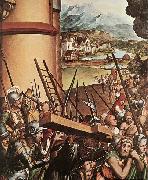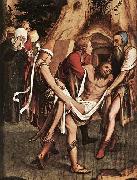Wholesale Oil Painting Reproductions No Minimum and Door to Door! |
|||||||||||
|
|
|||||||||||

|
|||||||||||
|
|
|
||||||||
All HOLBEIN, Hans the Younger Oil Paintings |
||||||||
|
|
||||||||
|
|
||||||||
|
Artist Introduction: German painter (b. 1497, Augsburg, d. 1543, London).
Hans Holbein the Younger, born in Augsburg, was the son of a painter, Hans Holbein the Elder, and received his first artistic training from his father. Hans the Younger may have had early contacts with the Augsburg painter Hans Burgkmair the Elder. In 1515 Hans the Younger and his older brother, Ambrosius, went to Basel, where they were apprenticed to the Swiss painter Hans Herbster. Hans the Younger worked in Lucerne in 1517 and visited northern Italy in 1518-1519. On Sept. 25, 1519, Holbein was enrolled in the painters' guild of Basel, and the following year he set up his own workshop, became a citizen of Basel, and married the widow Elsbeth Schmid, who bore him four children. He painted altarpieces, portraits, and murals and made designs for woodcuts, stained glass, and jewelry. Among his patrons was Erasmus of Rotterdam, who had settled in Basel in 1521. In 1524 Holbein visited France. Holbein gave up his workshop in Basel in 1526 and went to England, armed with a letter of introduction from Erasmus to Sir Thomas More, who received him warmly. Holbein quickly achieved fame and financial success. In 1528 he returned to Basel, where he bought property and received commissions from the city council, Basel publishers, Erasmus, and others. However, with iconoclastic riots instigated by fanatic Protestants, Basel hardly offered the professional security that Holbein desired. In 1532 Holbein returned to England and settled permanently in London, although he left his family in Basel, retained his Basel citizenship, and visited Basel in 1538. He was patronized especially by country gentlemen from Norfolk, German merchants from the Steel Yard in London, and King Henry VIII and his court. Holbein died in London between Oct. 7 and Nov. 29, 1543. With few exceptions, Holbein's work falls naturally into the four periods corresponding to his alternate residences in Basel and London. His earliest extant work is a tabletop with trompe l'oeil motifs (1515) painted for the Swiss standard-bearer Hans Baer. Other notable works of the first Basel period are a diptych of Burgomaster Jakob Meyer zum Hasen and his wife, Dorothea Kannengiesser (1516); a portrait of Bonifacius Amerbach (1519); an unsparingly realistic Dead Christ (1521); a Madonna and Child Enthroned with Two Saints (1522); several portraits of Erasmus, of which the one in Paris (1523 or shortly after), with its accurate observation of the scholar's concentrated attitude and frail person and its beautifully balanced composition, is particularly outstanding; and woodcuts, among which the series of the Dance of Death (ca. 1521-1525, though not published until 1538) represents one of the high points of the artist's graphic oeuvre. Probably about 1520 Holbein painted an altarpiece, the Last Supper, now somewhat cut down, which is based on Leonardo da Vinci's famous painting, and four panels with eight scenes of the Passion of Christ (possibly the shutters of the Last Supper altarpiece), which contain further reminiscences of Italian painting, particularly Andrea Mantegna, the Lombard school, and Raphael, but with lighting effects that are characteristically northern. His two portraits of Magdalena Offenburg, as Laïs of Corinth and Venus with Cupid (1526), |
||||||||
|
|
||||||||
|
The Passion Painting ID:: 63717 |
1524-25 Oil on limewood, 39 x 31 cm (size of detail) Kunstmuseum, ?ffentliche Kunstsammlung, Basle The picture shows a detail of the scene Via Crucis. The background of the scene opens up as a broad landscape. The perspective effect of distance is achieved by traditional colourist means, with the foreground, centre ground, and background being clearly distinguished in brown, greenish, and blue tones respectively. Continuity is provided by a procession of riders and infantry, whose size diminishes steadily towards the background, taking the eye into the landscape.Artist:HOLBEIN, Hans the Younger Title: The Passion (detail) Painted in 1501-1550 , German - - painting : religious |
|||||||
Height Width |
INS/CM Quality |
|||||||
|
X |
| |||||||
|
|
||||||||
All HOLBEIN, Hans the Younger Oil Paintings |
||||||||
|
|
||||||||
|
|
||||||||
|
Artist Introduction: German painter (b. 1497, Augsburg, d. 1543, London).
Hans Holbein the Younger, born in Augsburg, was the son of a painter, Hans Holbein the Elder, and received his first artistic training from his father. Hans the Younger may have had early contacts with the Augsburg painter Hans Burgkmair the Elder. In 1515 Hans the Younger and his older brother, Ambrosius, went to Basel, where they were apprenticed to the Swiss painter Hans Herbster. Hans the Younger worked in Lucerne in 1517 and visited northern Italy in 1518-1519. On Sept. 25, 1519, Holbein was enrolled in the painters' guild of Basel, and the following year he set up his own workshop, became a citizen of Basel, and married the widow Elsbeth Schmid, who bore him four children. He painted altarpieces, portraits, and murals and made designs for woodcuts, stained glass, and jewelry. Among his patrons was Erasmus of Rotterdam, who had settled in Basel in 1521. In 1524 Holbein visited France. Holbein gave up his workshop in Basel in 1526 and went to England, armed with a letter of introduction from Erasmus to Sir Thomas More, who received him warmly. Holbein quickly achieved fame and financial success. In 1528 he returned to Basel, where he bought property and received commissions from the city council, Basel publishers, Erasmus, and others. However, with iconoclastic riots instigated by fanatic Protestants, Basel hardly offered the professional security that Holbein desired. In 1532 Holbein returned to England and settled permanently in London, although he left his family in Basel, retained his Basel citizenship, and visited Basel in 1538. He was patronized especially by country gentlemen from Norfolk, German merchants from the Steel Yard in London, and King Henry VIII and his court. Holbein died in London between Oct. 7 and Nov. 29, 1543. With few exceptions, Holbein's work falls naturally into the four periods corresponding to his alternate residences in Basel and London. His earliest extant work is a tabletop with trompe l'oeil motifs (1515) painted for the Swiss standard-bearer Hans Baer. Other notable works of the first Basel period are a diptych of Burgomaster Jakob Meyer zum Hasen and his wife, Dorothea Kannengiesser (1516); a portrait of Bonifacius Amerbach (1519); an unsparingly realistic Dead Christ (1521); a Madonna and Child Enthroned with Two Saints (1522); several portraits of Erasmus, of which the one in Paris (1523 or shortly after), with its accurate observation of the scholar's concentrated attitude and frail person and its beautifully balanced composition, is particularly outstanding; and woodcuts, among which the series of the Dance of Death (ca. 1521-1525, though not published until 1538) represents one of the high points of the artist's graphic oeuvre. Probably about 1520 Holbein painted an altarpiece, the Last Supper, now somewhat cut down, which is based on Leonardo da Vinci's famous painting, and four panels with eight scenes of the Passion of Christ (possibly the shutters of the Last Supper altarpiece), which contain further reminiscences of Italian painting, particularly Andrea Mantegna, the Lombard school, and Raphael, but with lighting effects that are characteristically northern. His two portraits of Magdalena Offenburg, as Laïs of Corinth and Venus with Cupid (1526), |
||||||||
|
|
||||||||
|
|
The Passion Painting ID:: 63719 |
1524-25 Oil on limewood, 41 x 31 cm (size of detail) Kunstmuseum, ?ffentliche Kunstsammlung, Basle The picture shows a detail of the scene Entombment.Artist:HOLBEIN, Hans the Younger Title: The Passion (detail) Painted in 1501-1550 , German - - painting : religious |
||||||
Height Width |
INS/CM Quality |
|||||||
|
X |
| |||||||
|
|
||||||||
|
Prev Next
|
||||||||
|
|
||||||||
|
Related Paintings to HOLBEIN, Hans the Younger :. |
||||||||
|
|
||||||||
|
CONTACT US |


